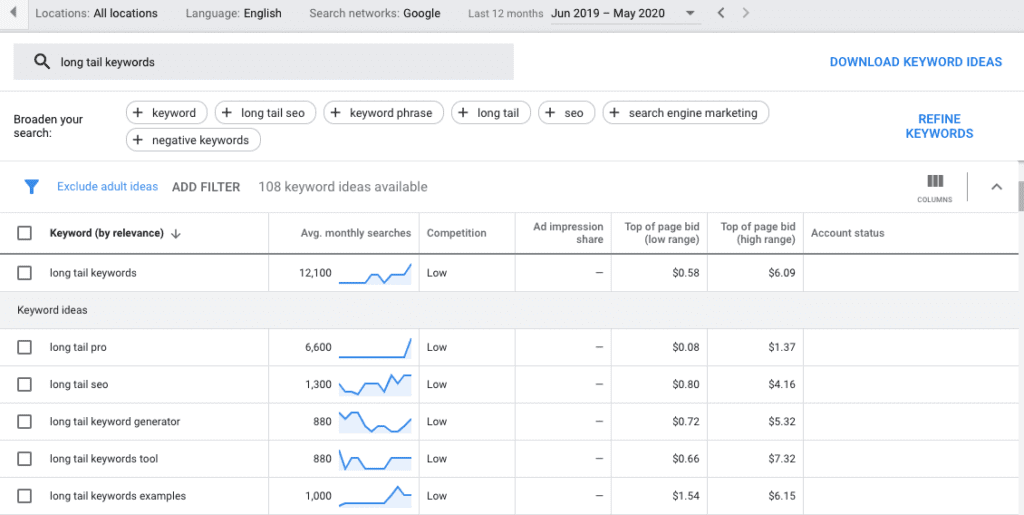One of the most effective SEO tactics are long-tail keywords – because they always work, even in niches with a lot of content. But what are long-tail keywords, and how do you use them for more SEO traffic?
This post will explain what long-tail keywords are and how bloggers can use them for more blogging success. Read on if you are struggling with SEO success and fail to rank for “normal” keywords in your niche. Or when you are competing for “normal” keywords but are struggling with the competition and want to add some more long-tail keyword power to the mix.
Why should you care about long-tail keywords?
To know identify what long-tail keywords are, we first have to understand what keywords are and what “normal” keywords are.
Keywords are essentially search terms, search phrases, and critical elements of longer search phrases that you compete for in Google search. “Normal” keywords are higher-level searches. For instance, our niche here at The Social Ms is “Online Marketing” – so this would be an excellent keyword for us, right?
Before you read on - we have various resources that show you exactly how to use social networks to gain massive traffic and leads. For instance, check out the following:
FREE Step-by-Step Twitter Marketing GuideFREE Pinterest Marketing Ebook
Well, not really…
Neil Patel’s excellent SEO research tool Ubersuggest allows us to do some research about the keyword:

There are an estimated 9900 searches on the keyword “Online Marketing” (which is good). Still, the SEO difficulty is estimated at 37. This isn’t too high, but you also need to calculate, that online marketing is a very saturated niche – with high ticket marketers competing for term. People and companies like Neil Patel (and his second company Quicksprout), Forbes, Hubspot, … See the screenshot below to see what the competition is for that keyword:

Now, we’re good here at The Social Ms, but not that good. Neil Patel invests 6 figures into his blog every month, and the others in this niche are doing the same.
Another problem with the keyword online marketing is: It’s not very targeted. Online marketing is a niche with many subtopics. So the first thing to do would be to rank for more targeted keywords. For instance, I could write an article about SEO, Google Updates, Social Media Marketing, Facebook Advertising, getting traffic from Twitter, etc…
And that’s when long-tail keywords start to come into play.
So, what are long-tail keywords?
Long-tail keywords are precise key phrases that focus on one particular topic. They are usually keyphrases with at least three and generally more than four words.
Hey, before you read on - we have in various FREE in-depth guides on similar topics that you can download. For this post, check out:
FREE workbook: CREATE AWESOME BLOG POSTSFREE Beginner's Guide: START A BLOG
Now, while high-level keywords get a lot of traffic, there are very few of these keywords. The majority of keywords is in the long-tail:
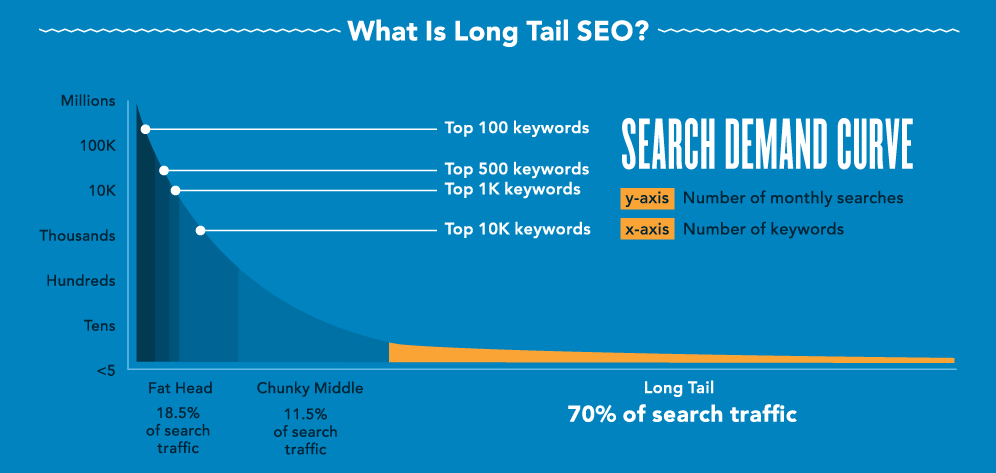
Image Source: Neil Patel
If you look at the image above, you can see that while the searches at the left side of the graph have the most searches, but that there are far more searches in the long-tail. An estimated 70% of all searches are in the long-tail, reaching only 10s to 100s of searches each month.
On the far end of the long-tail, there are those millions of search terms that only get a few searches each month – or even less. A lot of searches may only be entered once into Google search every year. Keep this in mind, as it is essential for coming up with a long-tail keywords strategy later.
For simplicity, in this post, I will count the “chunky middle” into the long-tail. The strategy described here will allow you to optimize for both at the same time.
Now here is an example:
For instance, a long-tail keyword for this article would be:
“What are long-tail keywords”
Let’s see:

Now, that looks a lot better. I might be able to rank for that, even in the top 10… Maybe… (As you can see, if you separate the “chunky middle” from the long-tail, this would be in the chunky middle in the image above.)
But of those 720 searches for this long-tail keyword, I might be able to get a piece.
If you do a search for this term, you will still get a lot of the top marketers competing. But what makes this keyword far easier to rank for, is, that they optimize their content not for the specific term, but for higher-level keywords like “Long-tail keywords.”
That’s my way in.
But that’s not the same as ranking for “online marketing” with 9900 searches per month – 720 is far away from a getting you the same traffic results compared to a search giving you almost 10,000. Sure, I might be ranking for that term and get a few clicks, but that’s not my goal. I want to increase my traffic as much as possible – and so do you.
A good long-tail keyword strategy takes care of that, too!
The long-tail keyword strategy
The beauty of long-tail keywords is:
Since you can rank for them more easily, no one can keep you from optimizing your content for more than one keyword.
For an excellent long-tail keyword strategy, your goal is not to rank for just one keyword. Your goal is to rank for as many searches in the long-tail as you can.
How do you do that?
That’s easier than you think – you start with research. The idea is to find as many long-tail keywords for your topic as you can. Not just one, but 10, or, depending on your piece up to 50. Or more.
This makes sense as these are often combinations of high-level keywords or just high-level keywords that have some single words added.
When you use this many long-tail keywords for your long-tail keyword strategy, you are effectively optimizing not just for those keywords but for the complete long-tail of your topic. This is because your long-tail keywords will be very close to most of the remaining long-tail searches.
For example, while I am optimizing this post for “What are long-tail keywords,” I am not optimizing for the related “What is long tail keywords” that Ubersuggest also proposes.
Let’s see about some long-tail keywords for this article as an example for long-tail keywords used for a strategic approach:
- What are long tail keywords
- Long tail keyword research
- Long tail keyword research tool
- Long tail keyword strategy
- …
I have done some research for writing this article about long-tail keywords, and the same tactics and strategies I am writing about I have used for this article.
But how can you find this many keywords?
The answer is that you need to use some long-tail keyword research tools and hacks.
Long-tail keyword research tools and hacks
The key to finding all the long-tail keywords that you want and need for your next content piece is to use keyword tools and a few hacks. Below you can find some tools to find long-tail keywords free of charge.
How to use Ubersuggest to find long-tail keywords?
Neil Patel’s Ubersuggest is a great starting point for finding long-tail keywords. You can even start with a high-level keyword – and once you do that, the tool will suggest several keywords you can also look at.
Let’s try that:
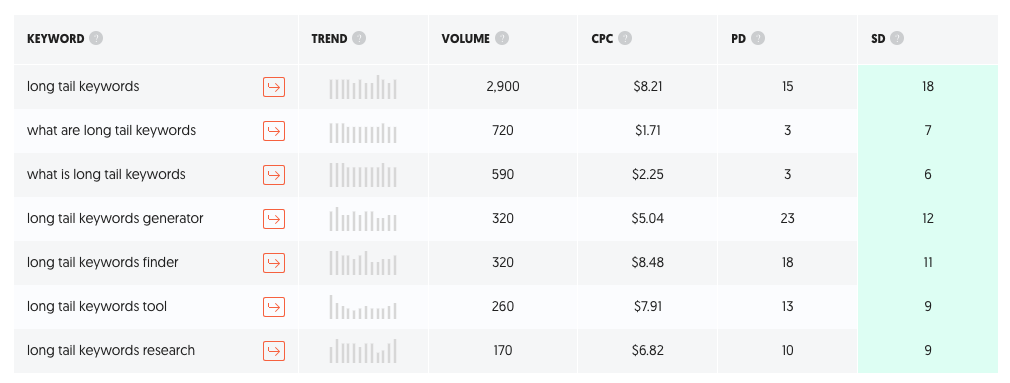
As you can see in the image above, Ubersuggest will suggest keywords that are seemingly related to your primary keyword. In fact, that is how I found my topic for this blog post – I started with the high-level keyword “Long-tail keywords” and found, that a relatively easy-to-rank-for keyword could be:
“What are long tail keywords”
(Note, that there is also “What is long tail keywords” – I am not optimizing specifically for that, but Google will make the connection hopefully.)
So I decided that this should be a topic for my post.
From that list, you can now even check for more related terms by entering your new-found long-tail keywords as a starting point in Ubersuggest.
You may not be able to use all of these keywords – some might be bad suggestions, some may be other high-level keywords. But to get the first list of long-tail keyword suggestions, this works really well.
Ubersuggest can be used with some limitations for free.
Hack: How to use Google search as a long-tail keyword research tool
Using two features provided by Google search can be very useful if you want to find more related long-tail keywords:
Autocomplete and Related searches.
Autocomplete is what happens when you start typing into Google search: Google begins to suggest what you want to search for automatically. And these suggestions are often great long-tail keywords that you can use for your content piece.

Another feature of Google’s search is the Related Searches box that appears on result pages below the search results:

As you can see, this can also give you useful long-tail keyword suggestions.
Using Google Keyword Planner as a long tail keyword Generator
Google’s tool, Keyword Planner, which is part of Google Adwords, can also be handy when looking for keyword suggestions. It’s part of the Adwords set of tools, but registering for Adwords is free.
Being part of Adwords also means that Keyword Planner isn’t a true SEO tool but a tool for advertising – but that doesn’t mean you cannot use it for SEO.
In fact, this is probably the best tool when you are looking for a list of seemingly unlimited long-tail keywords. There are no limitations on the number of results you can get for free from Keyword Planner.
How do you optimize content for long-tail keywords?
Now that you know how to find keywords let’s talk about the elephant in the room: Content optimization.
Many bloggers make a massive mistake when optimizing for long-tail keywords: They optimize for one keyword only!
Why is this a mistake? Since long-tail keywords are easier to rank for, optimizing just one keyword isn’t necessary. You can and should optimize for more than only one keyword!
But here is the problem, the available and most commonly used SEO optimization plugins in WordPress seemingly force you to optimize for just one keyword or at most three. But that doesn’t mean you have to work like that!
Let’s go over the process:
Your keyword research gave you a topic for a post. Since you’ve written the post after your keyword research, you wrote a post that is already optimized at least in no small degree for your long-tail keyword.
Now that you have your first draft, you enter the second phase of optimization – using SEO tools like the Yoast plugin for WordPress.
Let me show you how I optimize this post in WordPress using the free version of the Yoast SEO plugin.
I start with my high-level keyword in this case, because I want this post to be cornerstone content as well. I enter this as a keyword in the Yoast SEO plugin and optimize as usual until Yoast gives me the green light.
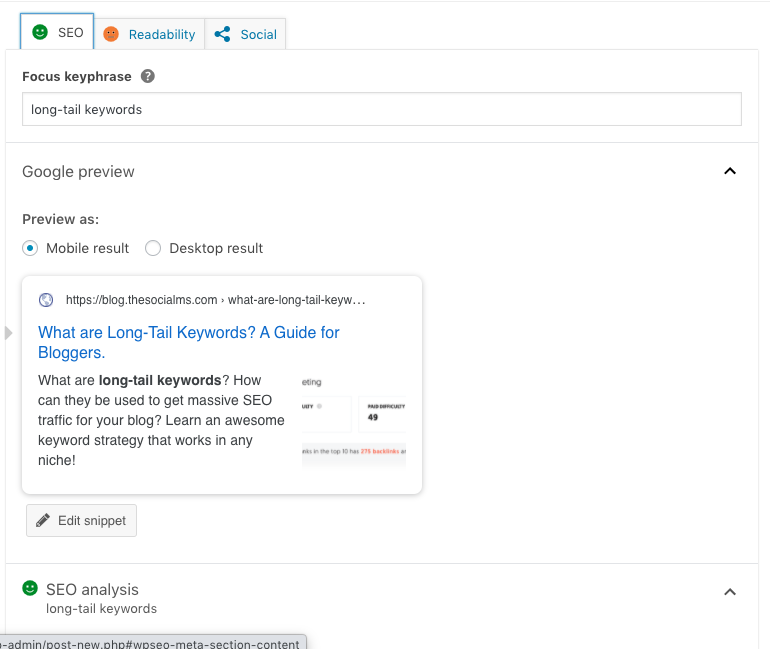
Now, I simply delete my first keyword from Yoast and enter the keyword that most resembles the topic of the post. In this case:
“What are long-tail keywords”
And optimize for this keyword as best as I can. Most optimizations that I made for the high-level keyword will stay.
Since this is a long-tail keyword and an exact phrase, I might not be able to get a green light, but since I started with my high-level keyword, my post is still well optimized.
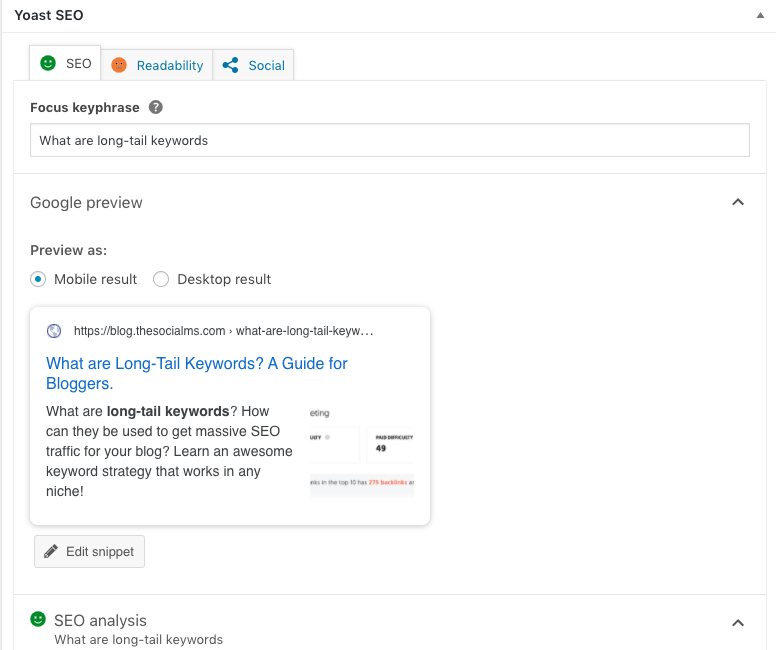
I could have started with this keyword right from the beginning, and in most cases, I would have, but this post is cornerstone content, so I chose this route.
Now, what can you do with all your long-tail keyword research? Will you have to optimize your post over and over again for up to 50(!) keywords?
Well, you could, but it’s not necessary.
Instead, what I do and what you should do is: Simply go over your post and add your long-tail keywords wherever it makes sense in case of this post.
For instance, in this post, I have added:
- Long-tail keyword research
- Long-tail keyword research tools
- long-tail keyword strategy
- long-tail keyword generator
- and many more…
In fact, I recommend going over your post this way at least twice – there are always more opportunities.
Bonus: How do you optimize old posts for long-tail keywords?
Now, there is one final aspect of long-tail keywords that I want to mention. This may be the most essential aspect that can give many bloggers the most significant traffic increase.
And these are your existing posts.
If you’ve been blogging for a while, there are probably a lot of existing posts that you wrote for a high-level keyword. But not all of them get a lot of search traffic. 
Or posts that you didn’t optimize for a specific topic at all – because you couldn’t find high-level keywords with tons of traffic.
Now, updating old posts is already highly recommended for SEO reasons. But here is a tactic that you can use to increase the SEO traffic to your existing post – and keep them current:
Just like before, do your research – use the tools and tactics described above to find 10 to 15 related long-tail keywords.
And now, add these to your post. Add more paragraphs where needed, sprinkle those keywords throughout your content, and use these as a guide for updating your content.
Doing this regularly with old posts will increase the SEO value of your blog massively.
Final words
In this post, you learned what long-tail keywords are and how you can use them to increase the search traffic to your blog. You’ve learned about using long-tail keyword SEO for old posts. And you’ve learned about long-tail keyword research tools and hacks.
Using this tactic for SEO can give you SEO traffic even in crowded and saturated niches.
Are you already using long-tail keywords? What are your experiences?
Are you struggling with your SEO? Do you think you have done so much but somehow your blog traffic from Google search is stagnating? Do you need some help with setting up your blog for SEO? Are you not sure how to build links to your blog?
We have got you covered!
We created a free email course about SEO for your blog – or SEO with a blog. Join today for 4 days and 4 emails and learn about on-page SEO, Google Ranking factors, link building tactics and how to find keywords even you can rank for. Join our (free) email course about Blog SEO today!


